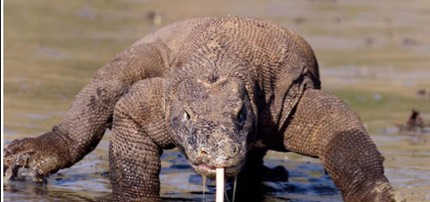

Some recent research suggests that Komodo dragons might also be venomous due to some of the properties of components in their saliva. In addition, Komodo dragon saliva contains potentially harmful bacteria that are thought to help weaken prey that are too large for a single dragon to overpower. Fortunately, the young spend their lives in trees, which likely helps reduce their risk of predation from the adults. Komodo dragons may also be cannibalistic. Some dragons have visible scars from conflicts with wild boars. On Rinca and Komodo islands, pigs have become common in some areas and are now competitors for food with the big lizards. Komodo dragons also eat water buffalo and wild pigs, both of which were introduced by man, as well as snakes and fish that wash up on the shore. If the prey escapes, the dragon can rely on its long tongue to find its whereabouts, even up to a mile away (1.6 kilometers) away! When the deer passes by, the dragon uses its long claws and sharp teeth to attack. The deer are wary and quite agile, requiring the dragon to resort to lying in ambush in the long grass next to game trails, in order to be successful in hunting. Its natural prey, however, is the Timor deer. It is a solitary creature that lives and hunts alone.Īn adult Komodo dragon eats whatever food is available. After a late afternoon meal, the dragon is ready for bed, sleeping soundly in its burrow until a new day begins.

Then it’s off to find breakfast, followed by a nice long nap in the shade during the hottest part of the day. It emerges from its burrow to look for a sunny spot to warm up in. However, not all Komodo dragons use burrows in fact, one adult male on Komodo Island often sleeps at night in an abandoned hut that visitors used to stay in!Īn adult dragon leads a life of leisure. Sometimes these burrows can be seen along the slopes of dry streambeds among tree roots. They may either make their own burrows or use an existing one another lizard created. Some dragons scratch shallow burrows to rest in at night to keep warm and as a cool shelter to retreat to from the heat of the day. Komodo dragons have the smallest home range of any large predator in the world! They like it hot, with daytime temperatures during the dry season that often reach 95 degrees Fahrenheit (35 degrees Celsius) with 70-percent humidity. The islands are volcanic in origin, rugged and hilly, and covered with both forest and savanna grassland. Komodo dragons live on only five islands in southeastern Indonesia: Indonesia’s four islands within Komodo National Park (Komodo, Rinca, Gili Montang, Gili Dasami), and the island of Flores.


 0 kommentar(er)
0 kommentar(er)
